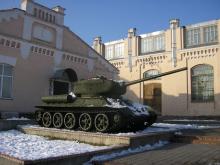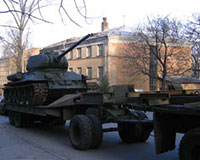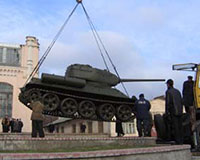On December 2, 2005 at NTUU "KPI" brought a new exhibit to the State Polytechnical Museum - legendary "trydtsatychetvirka".
By the way, cases of T-34 tanks welded on the technology developed by professor of KPI academician E.A. Patton, the monument to which is established opposite to an entrance to the museum
The T-34 was a Soviet medium tank design of World War II is created on the basis of average A-32 and it is taken advantage in December, 1939. It was produced in lots since 1940, I was the RKKA main tank to the first half of 1944 when it was succeeded by the tank of modification of T-34-85. The most mass average tank of World War II.
Developed by design office of tank department of the Kharkov plant №. 183 under the leadership of M. I. Koshkin. Success of the project was caused by application of a new, high-economic diesel engine of aviation type: "V-2" thanks to which, average-tovstobronny T-34 inherited from easy-tonkobronnogo BT extremely high specific power (the engine capacity relation to fighting weight) provided during all World War II, absolute advantage of the T-34 tank in passability, maneuverability, mobility, and also a weight reserve for modernization taking into account the saved-up experience of fighting application.
Also against charging bookings, powerful arms and a reliable running gear in the car for the first time are organically combined. Anticharging bookings is provided not only application of rolled armored sheets of big thickness, but also their rational inclination. Thus connection of sheets was carried out by method of manual welding which during production was replaced with automatic welding. The tank armed with a 76,2-mm gun of L-11 which was soon was replaced with more powerful gun of F-32, and then and F-34. Thus, on arms he answered the heavy KV-1 tank.
High mobility was provided with the powerful diesel engine and wide caterpillars. High technological effectiveness of a design allowed to arrange a mass production of T-34 at seven engineering plants of the Urals and Siberia, various on equipment, and proceeded and in post-war years. The Ural tank plant No. 183 was the leading plant on modification of T-34. The last modification (T-34-85) consists on arms of some countries and to this day. In total in the years of war 52 thousand T-34 tanks which took part in all fights.
The T-34 tank is the most known Soviet tank and one of the most recognizable symbols of World War II. It is a lot of these tanks of various modifications in the form of monuments and museum pieces of time remained to the present



